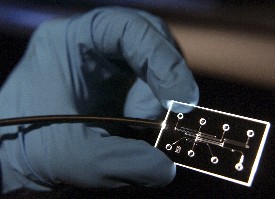Researchers from universities in the U.S., U.K., and China are developing new processes that combine a laser and electric fields to manipulate fluids and tiny particles such as bacteria, viruses, and DNA on miniature chip-sized analytic devices. These advances, with applications ranging from drug manufacturing to food safety, are described in the current issue of the journal Lab on a Chip.
The method, called hybrid optoelectric manipulation in microfluidics, is a potential new diagnostic tool that performs measurements normally requiring large laboratory equipment. The technology uses a red laser to position a droplet on a platform prepared at Purdue University in West Lafayette, Indiana. Steven Wereley, professor of engineering at Purdue and several of his former students are authors of the paper.
An infrared laser then heats the droplets, followed by electric fields that cause the heated liquid to circulate in a miniature vortex. This vortex acts like a centrifuge to isolate specific types of particles in the circulating liquid. Particle concentrations replicate the size, location and shape of the infrared laser pattern.
Stuart Williams, also a Purdue engineering professor and co-author, says the technology two types of applications. “The first is micro- and nanomanufacturing and the second is lab-on-a-chip sensors,” says Williams. “The latter has demonstrated biologically relevant applications in the past couple of years, and its expansion in this field is immediate and ongoing.”
Williams believes the technology is ready for some applications, including medical diagnostics and environmental samples. Wereley adds that Purdue researchers also are pursuing the technology for pharmaceutical manufacturing.
Read more: Pump Designed for Lab-on-a-Chip Medical Diagnostics
* * *


 RSS - Posts
RSS - Posts
[…] Read More: Lasers, Electric Fields Aid Lab-on-a-Chip Technology […]
[…] Read more: Lasers, Electric Fields Aid Lab-on-a-Chip Technology […]